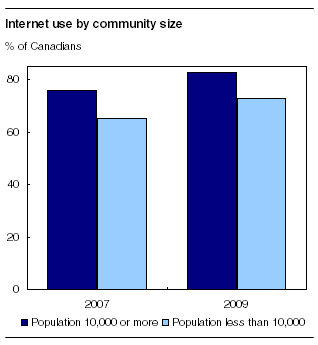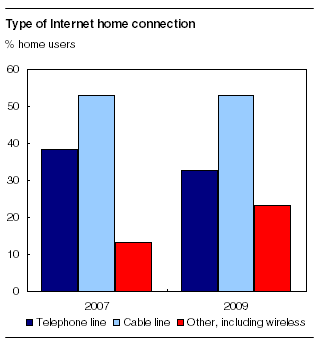Common menu bar links
Canadian Internet Use Survey
Archived Content
Information identified as archived is provided for reference, research or recordkeeping purposes. It is not subject to the Government of Canada Web Standards and has not been altered or updated since it was archived. Please "contact us" to request a format other than those available.
Related subjects
In 2009, 80% of Canadians aged 16 and older, or 21.7 million people, used the Internet for personal reasons, up from 73% in 2007 when the survey was last conducted.
Rates of Internet use increased in every province during this two-year period. The largest relative increase in Internet users occurred in New Brunswick and Newfoundland and Labrador (+15% each over 2007). Rates were highest at 85% in both British Columbia and Alberta, followed by 81% in Ontario.
Among census metropolitan areas, the highest rates of Internet use were reported in Calgary and Saskatoon, both at 89%. They were followed by Edmonton, Ottawa–Gatineau, Vancouver and Victoria, at around 86% each.
Among Canadians living in communities with a population of 10,000 or more, 83% used the Internet compared with 73% of those from communities with fewer people. This "digital divide," that is, the gap in the rate of Internet use on the basis of community size, has persisted since 2007, when the respective proportions were 76% and 65%.

Other "digital divides" narrowing
Digital divides on the basis of income, education and age narrowed between 2007 and 2009.
To examine the Internet use divide by income, Canadians were divided into four equal groups, or quartiles, based on household income. The vast majority (94%) of people from households in the top quartile, those with incomes of $85,000 or more, used the Internet, compared with 56% among households in the lowest quartile, those with incomes of $30,000 or less. The respective proportions in 2007 were 90% and 48%.
As for the divide by education, 89% of individuals with at least some post-secondary education used the Internet in 2009, compared with 66% among those with no post-secondary education. This divide narrowed from 84% and 58% in 2007 respectively.
Note to readers
The 2009 Canadian Internet Use Survey, sponsored by Industry Canada, was conducted in November as a supplement to the Labour Force Survey.
More than 23,000 Canadians aged 16 years and over were asked about their Internet use, including shopping, for the previous 12 months. This release contains results for Internet use by Canadians.
Data on Internet shopping (e-commerce) will be released later in 2010.
Definitions
An "Internet user" is someone who used the Internet for personal reasons from any location in the 12 months preceding the survey. A "home user" is someone who reported using the Internet from home.
Communities are divided into those with a population of 10,000 or more – defined by Statistics Canada's census metropolitan areas and census agglomerations – and those with fewer than 10,000 persons.
On the basis of age, Internet use increased among all groups but at different rates. In 2009, 98% of people aged 16 to 24 went online, up slightly from 96% two years earlier. Of those aged 45 or older, two-thirds (66%) went online during 2009, up from 56% in 2007. This age group, traditionally slower to adopt and use the Internet, accounted for 60% of all new Internet users since 2007.
A similar proportion of men (81%) and women (80%) used the Internet in 2009.
Regular home use now commonplace
Most (96%) Internet users aged 16 or older reported going online from home during 2009, while 42% said they used it from work, 21% from schools and 15% from libraries.
Among those who used the Internet from home, 75% went online every day during a typical month, up from 68% in 2007. In 2009, 55% were online for five hours or more during a typical week, up from 49% in 2007.
Growth in high-speed and wireless connections
Among people who accessed the Internet from home in 2009, 92% did so with a high-speed connection, up from 88% two years earlier.
The vast majority (94%) of home users living in communities with a population of 10,000 or more accessed the Internet through a high-speed connection. This compares with 84% of those living in communities with less than 10,000 people.
Among those in smaller communities who were not connected by high-speed access, one-half (50%) reported that a cable or telephone high-speed service was not available to them.
In 2009, 53% of home users were connected to the Internet by cable and 33% by telephone. Other types of home connections, mostly wireless, increased to 23% in 2009 from 13% in 2007.

The types of home connections differed from region to region. In the Atlantic provinces, 41% of home users were connected by telephone, while 57% were connected by cable in Quebec and British Columbia. In the Prairie provinces, 30% reported other types of connections.
More searching, downloading and posting
E-mail was still the most common online activity from home in 2009. Searching for health information online was reported by 70% of home users, up from 59% in 2007.
Online transactions were more prominent in 2009, with 50% of home users reporting ordering goods or services over the Internet and 67% going online for electronic banking or bill payment.
In 2009, 31% of home users reported downloading or watching TV or movies, while 27% reported contributing content by writing blogs, posting photographs or joining discussion groups.
Rates for these activities varied with characteristics such as age and sex. For instance, 53% of home users under the age of 30 went online to download or watch TV or movies, while 45% of this age group reported contributing content.
Among home users in 2009, 74% of women used the Internet to search for information about health or medical conditions, while 66% of men did so. However, 35% of men used the Internet to research investments, compared with 20% of women.
Online privacy and security concerns
Canadians who had used the Internet for five or more years were less likely to be concerned about online security than those with fewer years of online experience.
Of those who reported using the Internet for less than five years, 55% were very concerned about online credit card use and 50% about banking over the Internet. These proportions dropped to 42% and 37%, respectively, for those reporting five or more years of Internet use.
By 2009, 65% of all Canadians reported using the Internet for five or more years, up from 54% in 2007. As well, people who had used the Internet longer also reported a wider range of online activities.
In 2009, one-third (33%) of Internet users were very concerned about online privacy in 2009.
Available on CANSIM: tables 358-0122 to 358-0126, 358-0128 to 358-0130, 358-0132 and 358-0134.
Definitions, data sources and methods: survey number 4432.
Data tables are available from our website under Summary tables.
For more information, or to enquire about the concepts, methods or data quality of this release, contact Larry McKeown (613-951-2582, larry.mckeown@statcan.gc.ca) or Ben Veenhof (613-951-5067, ben.veenhof@statcan.gc.ca), Business Special Surveys and Technology Statistics Division.
Table 1
| 2007 | 2009 | |
|---|---|---|
| % | ||
| Canada | 73 | 80 |
| Newfoundland and Labrador | 61 | 69 |
| Prince Edward Island | 69 | 77 |
| Nova Scotia | 69 | 76 |
| New Brunswick | 65 | 73 |
| Quebec | 69 | 77 |
| Ontario | 75 | 81 |
| Manitoba | 70 | 77 |
| Saskatchewan | 73 | 79 |
| Alberta | 77 | 85 |
| British Columbia | 78 | 85 |
Table 2
| 2007 | 2009 | |
|---|---|---|
| % | ||
| 92 | 93 | |
| General browsing for fun or leisure | 76 | 78 |
| Obtain weather or road conditions | 70 | 75 |
| Research other matters (family history, parenting) | 70 | 73 |
| Search for medical or health related information | 59 | 70 |
| View news or sports | 64 | 68 |
| Electronic banking or bill payment | 63 | 67 |
| Travel information or making travel arrangements | 66 | 66 |
| Window shopping | 60 | 65 |
| Search for information about governments | 51 | 57 |
| Education, training or school work | 50 | 50 |
| Research community events | 44 | 50 |
| Order personal goods or services | 45 | 50 |
| Obtain or save music (free or paid downloads) | 45 | 47 |
| Use an instant messenger | 50 | 45 |
| Play games | 39 | 42 |
| Obtain or save software (free or paid downloads) | 33 | 35 |
| Job search | 32 | 35 |
| Listen to the radio over the Internet | 28 | 32 |
| Download or watch TV or a movie over the Internet | 20 | 31 |
| Research investments | 25 | 27 |
| Communicate with governments | 26 | 27 |
| Contribute content (blogs, photos, discussion groups) | 20 | 27 |
| Make telephone calls | 9 | 14 |
| Sell goods or services (auction sites) | 9 | 13 |

